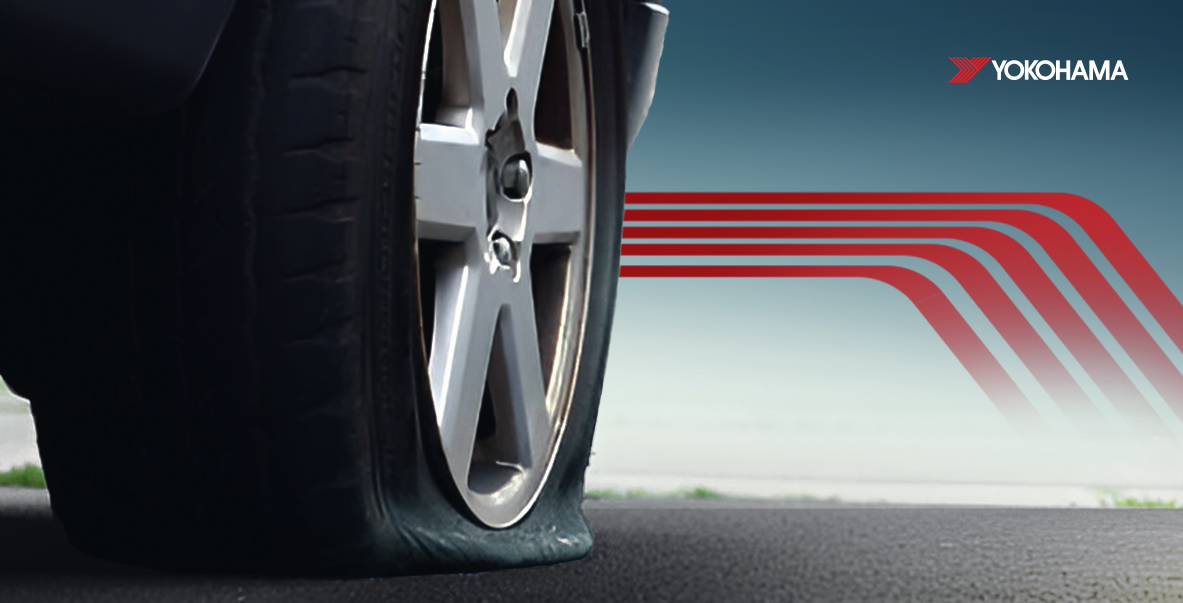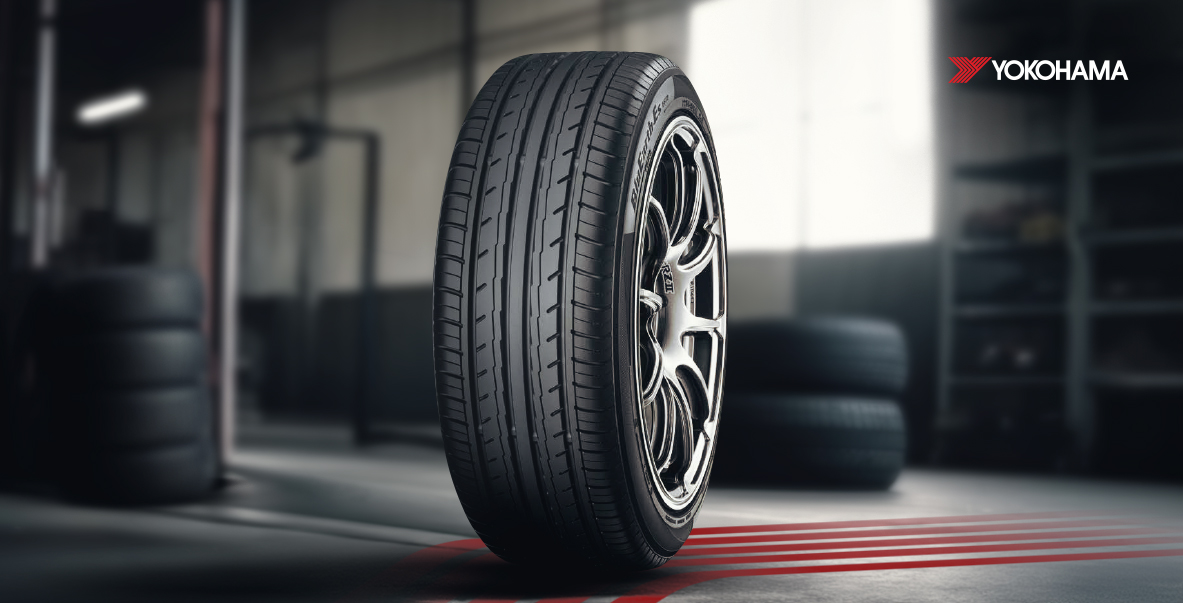Maintaining the health of your vehicle’s tyres is crucial for safe driving and optimal performance, as they are the only point of contact between your car and the road. Worn-out tyres can drastically reduce your car’s efficiency and, more importantly, pose significant safety risks, such as increased braking distance and the likelihood of blowouts.
In fact, the National Highway Traffic Safety Administration (NHTSA) reports that vehicles with worn-out tyres are three times more likely to be involved in crashes during wet weather than vehicles with adequate tread.
This comprehensive guide will help Malaysian drivers identify worn-out tyres and provide essential maintenance tips to ensure a smooth, safe, and worry-free driving experience.
What are worn-out tyres and why are they a problem?

Worn-out tyres are more prone to punctures and blowouts.
Worn-out tyres are those that have lost their tread depth and structural integrity, often falling below the legal minimum of 1.6 mm. This reduction in tread depth diminishes traction, increases the risk of hydroplaning (where your tyres lose contact with the road due to a thin layer of water), and leads to longer braking distances.
They are more prone to punctures and blowouts, compromising vehicle handling and safety. Regular inspection and timely replacement are essential to maintaining road safety and performance.
7 signs your tyres are worn out
Identifying worn-out tyres is the first step toward ensuring your safety on the road.
1. Tyre tread depth
The most obvious sign of worn-out tyres is reduced tread depth. Tyres with less than 1.6 mm of tread are not just dangerous, but it is illegal to drive on them, particularly in wet conditions where traction is critical. There are two easy methods to check your tread depth:
- Coin Test: Insert a coin into the tread groove. If the tread does not reach the top of the coin, your tyres have worn down to the minimum depth and need replacement.
- Tread Wear Indicator: Modern tyres include wear bars moulded into the tread. If these bars are flush with the tread surface, you should consider changing them.
For more accurate measurement, using a tread depth gauge is recommended over these easier alternatives, which provide only a quick rough estimate.
2. Uneven tread wear
Uneven tread wear patterns can indicate issues such as poor wheel alignment, improper tyre pressure, or faulty mechanical parts such as absorbers. Look for signs of wear along the inside or outside edges of the tyre.
Regular alignment checks are imperative, especially after hitting a pothole or curb. Misalignment can cause the vehicle to pull to one side, leading to uneven wear and reduced tyre lifespan.
3. Tyre sidewall cracking
Over time, tyres can develop cracks in the sidewall due to exposure to environmental factors like UV rays. While minor cracks may not be immediately dangerous, deeper cracks indicate significant rubber deterioration and an increased risk of tyre failure.
Regularly check the sidewalls for cracks to catch these issues early. Additionally, sidewall bulges caused by impacts with road hazards like potholes can be a sign of internal tyre damage and require immediate replacement.
4. Vibrations and strange noises
If you notice vibrations or strange noises while driving, it could indicate that your tyres are out of balance or have internal damage. This can cause your car to shake or wobble, making it difficult to steer and affecting ride comfort and safety. Immediate professional inspection is recommended if these symptoms are observed.
5. Age of tyres
Tyres age even when they are not in use. Over time, the rubber compound deteriorates, making them more susceptible to cracking and blowouts. It’s recommended to get a replacement every five years, regardless of tread wear.
This is especially important in hot climates like Malaysia, where high temperatures accelerate rubber degradation, making older tyres less effective in terms of grip, traction, and performance.
6. Tyre pressure fluctuations
Tyre pressure plays a crucial role in its performance and safety. Significant changes in its pressure can indicate underlying issues, such as leaks or permeation through the tyre walls.
If you notice frequent pressure drops, have your tyres checked for leaks or damage. Proper tyre inflation is essential for preventing uneven wear, maintaining optimal performance, and ensuring safe driving.
7. Sudden loss of pressure or blowout
A sudden loss of pressure or a blowout is a severe sign of tyre damage. Various factors, including impact with road hazards, excessive wear, or improper inflation, can cause these incidents.
If you experience a sudden loss of tyre pressure or a blowout, safely pull over to the side of the road, turn on your hazard lights, and have your tyres inspected immediately. Always ensure your spare tyre is in good condition and carry the necessary tools for tyre changes.
How to proceed if you observe tyre wear signs
If you notice any of the signs of tyre wear listed above, it’s important to have your tyres inspected by a qualified mechanic. In Malaysia, professional tyre shops like Yokohama Malaysia can offer expert advice and services. They will tell you if your tyres need to be replaced and can also recommend any other repairs that may be necessary.
In addition to regular inspections, there are a few things you can do to help extend the life of your tyres:
- Rotate your tyres regularly: This helps ensure that your tyres wear evenly, prolonging their lifespan.
- Keep your tyres properly inflated: Under-inflated tyres can cause uneven wear and make your car more difficult to control.
- Avoid driving over potholes and other road hazards: These can damage your tyres and cause them to wear out prematurely.
- Regular Wheel Alignment: Ensures that your tyres wear evenly and your vehicle maintains optimal handling.
By taking care of your tyres, you can help to ensure that they last longer and that you stay safe on the road.
Conclusion
According to the World Health Organization (WHO), road traffic injuries are the leading cause of death for people aged 15-29 years globally, and vehicle defects, including tyre issues, significantly contribute to these accidents. Proper tyre maintenance can reduce these risks.
Taking proactive steps in tyre care not only contributes to a more reliable and enjoyable driving experience but also significantly enhances safety, providing peace of mind for both you and your passengers on every journey.
Yokohama Malaysia offers a range of premium tyres and expert services to help you manage worn-out tyres effectively. With advanced tyre technology and a commitment to quality, Yokohama provides tyres that deliver:
- Superior Performance with their ADVAN series.
- Outstanding Durability with their GEOLANDAR series.
- Excellent Efficiency with their BluEarth series.
A professional team can assist with selecting the right tyres for your vehicle, ensuring proper installation, and offering regular maintenance services. By choosing Yokohama Tyres, you can ensure your vehicle remains safe and efficient on the road.
FAQ
What causes uneven tyre wear and how can I prevent it?
Uneven wear is often due to improper pressure, misalignment, or suspension issues. To prevent it, ensure regular maintenance, including checking pressure, rotating tyres, and having a professional inspect the alignment. These steps help maintain an even contact patch with the road surface, extending the life of your tread.
How can I identify a worn-out tyre, and when should it be replaced?
Worn-out tyres can be identified by reduced tread depth, visible wear indicators, or signs of damage like cracks or bulges. If the tread depth is below 1.6 mm or shows signs of deterioration, it’s time for a replacement. Regular inspections by a professional can help you determine when to replace them to avoid blowouts or other safety issues.
What should I do if I experience a flat or blowout?
If you experience a flat or blowout, safely pull over and turn on your hazard lights. Inspect the tyre to assess the damage. If a spare is available and in good condition, you can replace the flat. If not, seek help from a professional. Regular inspections and maintenance can reduce the risk of blowouts and keep your tyres in good condition.
How do rear tyres differ from front ones in terms of wear, and how can I ensure they wear evenly?
Rear tyres typically wear more slowly than front ones due to different stress levels from steering and braking. To ensure even wear, rotate your tyres regularly according to the vehicle manufacturer’s recommendations. Proper alignment, balanced tyres, and maintaining the correct pressure are crucial in preventing excessive wear and extending their lifespan.


